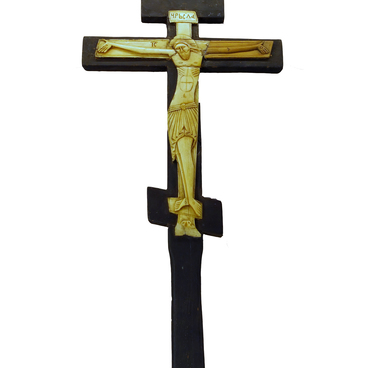The blessed cross is kept on the table in the church altar. Usually, it has a special handle fixed to it. The ritual object is used when the minister says the Dismissal, final blessing of the parishioners at the close of the service. Then, before leaving the church the parishioners would traditionally kiss the cross. The altar cross, the altar Gospel, and antimension, piece of cloth with a small relic of some Orthodox martyr sewn into it — all those are obligatory furnishings of the altar, the church central part.
This blessed cross dates to 1703. It comprises two parts — the upper one represents a thin four-point cross with bars on each end. Its face is decorated with gems and pieces of glass, and is covered by filigree work, cabled ornament in 8-shaped pattern. The backside is framed and covered with inscriptions in the Greek language. The lower part of the blessed cross has a handle with two scrolls attached to it.
The cross was donated to the church by an Uglich merchant Feodor Gnezdikov. The residents of the town and suburbs worshiped the cross and would come to pray at it from a distance of 20 to 30 verst (20 to 30 kilometers). Some believers said that their woes were relieved once they took holy water sanctified by the cross.
This blessed cross dates to 1703. It comprises two parts — the upper one represents a thin four-point cross with bars on each end. Its face is decorated with gems and pieces of glass, and is covered by filigree work, cabled ornament in 8-shaped pattern. The backside is framed and covered with inscriptions in the Greek language. The lower part of the blessed cross has a handle with two scrolls attached to it.
The cross was donated to the church by an Uglich merchant Feodor Gnezdikov. The residents of the town and suburbs worshiped the cross and would come to pray at it from a distance of 20 to 30 verst (20 to 30 kilometers). Some believers said that their woes were relieved once they took holy water sanctified by the cross.
An Uglich legend says that the cross in question was brought in from Greece during the war with Turkey, but it remains unclear exactly which war is meant here. The Greek origin of the cross is confirmed by the inscriptions on its backside. Apparently, inscription in the Russian language were added later, already in Russia. One of the inscriptions is the name of the donator.An Uglich legend says that the cross in question was brought in from Greece during the war with Turkey, but it remains unclear exactly which war is meant here. The Greek origin of the cross is confirmed by the inscriptions on its backside. Apparently, inscription in the Russian language were added later, already in Russia. One of the inscriptions is the name of the donator.
Christians had almost never used the image of the cross before the appearance of Emperor Constantine’s the Christian monogram in the 4th century. According to the legend, Christ appeared to the Emperor and ordered to use a banner with the image of a cross in the battle with his enemies. Then, the sign was hammered on the coins of the time, and later when it turned into a symbol of Christianity, crosses were crafted with rich decorations, and blessed crosses were often manufactured as jewelry items.Christians had almost never used the image of the cross before the appearance of Emperor Constantine’s the Christian monogram in the 4th century. According to the legend, Christ appeared to the Emperor and ordered to use a banner with the image of a cross in the battle with his enemies. Then, the sign was hammered on the coins of the time, and later when it turned into a symbol of Christianity, crosses were crafted with rich decorations, and blessed crosses were often manufactured as jewelry items.




